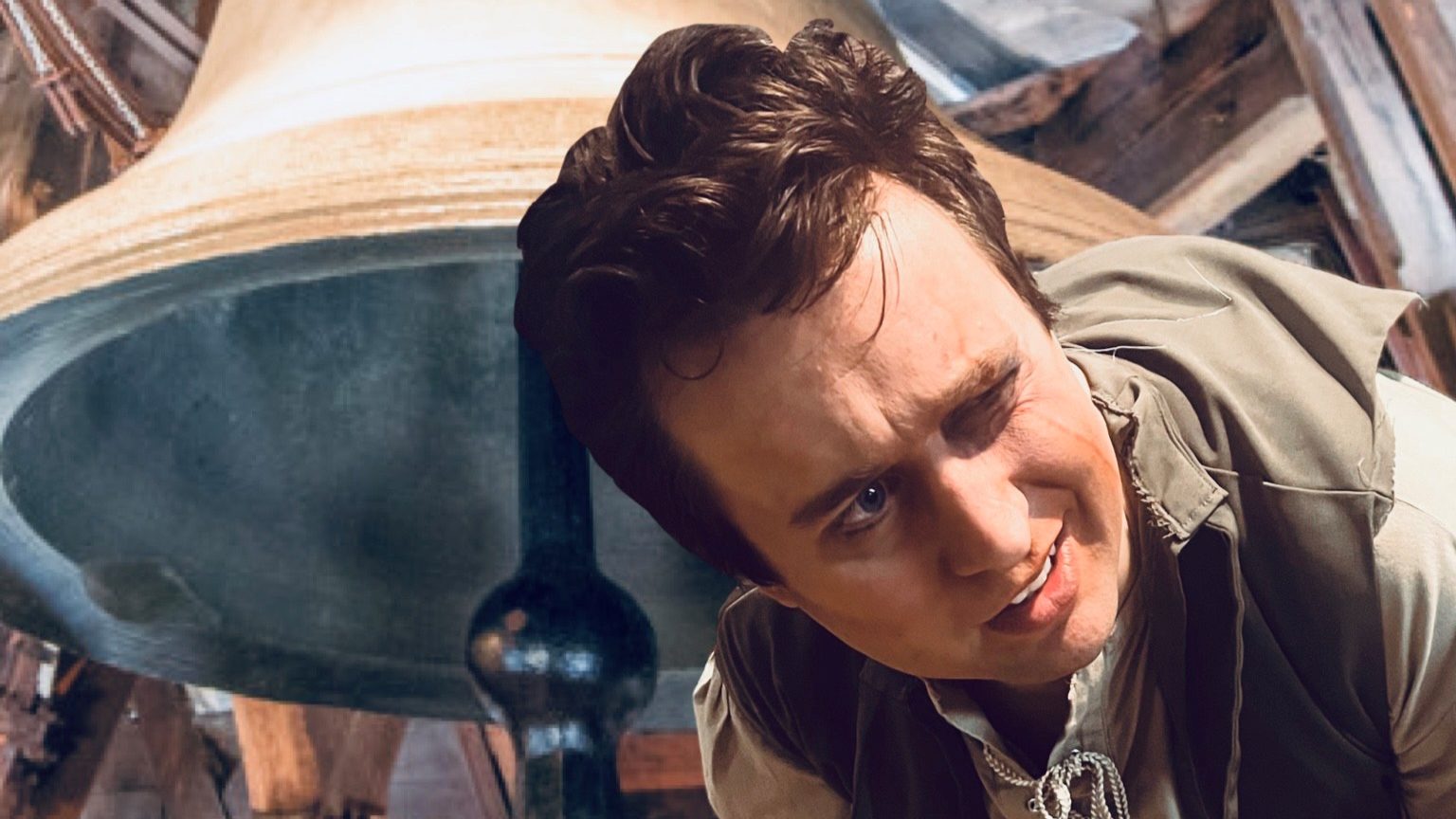DRAPER — When I saw that The Hunchback of Notre Dame was included in the 2022 season lineup at Draper Historic Theatre, I was initially surprised and apprehensive that a small, low-budget theatre was attempting a show that was this ambitious. However, this company and the director of this production, Eldon Randall, rose to the challenge nicely.
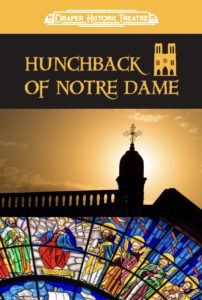
With music by Alan Menken, lyrics by Stephen Schwartz, and book by Peter Parnell, The Hunchback of Notre Dame is based on the 1831 novel written by Victor Hugo with some of the same songs from the animated 1996 Disney film adaptation. The music in the stage adaptation of the show is difficult and complex, and music director Courtney Byrom has done excellent work with this cast. The show opens with the ensemble proceeding down the aisles of the theatre, singing the opening number “The Bells of Notre Dame.” The ensemble sounded rich and full, and they mastered their harmonies well. They also mastered the difficult harmonies in the Entr’acte at the top of Act 2, making it one of the best musical numbers in the show.
There was no set for this production, but company made nice use of projections (designed by Rob Reins) to create the scenes in the show, and the stage was painted to resemble stained glass. All of this came together nicely to create the atmosphere of the Notre Dame Cathedral in Paris. Some of the characters also used the upper balconies on the left and right sides of the stage, which created interesting levels throughout the show.
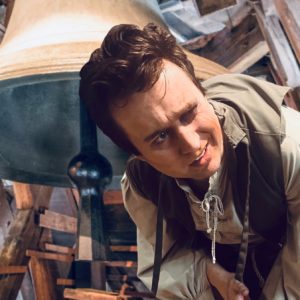
The show is led by Travis Wright as Quasimodo, and one of the first things I noticed was the cool artistic choice to use a white contact lens in his left eye and some great use of makeup to create the illusion of deformity on Wright’s left side. Wright does an excellent job portraying the kindhearted, childlike innocence of Quasimodo, but does not quite have the vocal strength or technique for this vocally challenging role. His performance of “Out There” was broken by numerous voice cracks and intonation issues, which took me out of the moment. He ran into this same issue again with his renditions of “Heaven’s Light” and “Made of Stone” However, he has excellent interactions with his co-star Tyson Jensen, playing the role of Claude Frollo, and the pair did very well to believably portray the imbalance of power in their uncle-nephew relationship. I could feel Quasimodo’s fear and submission in all of his scenes with Frollo. Wright even learned some sign language which he used in the show, which was a great addition to his character.
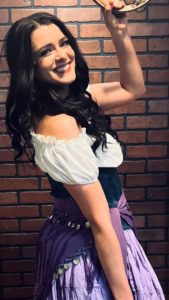
For this production, the role of Clopin was split into two actors: one male and one female, played by Trevor Noble and Karlie Parrish. This was an interesting artistic choice, but it did not quite work as the other characters in the show kept referring to Clopin as one person, even though they were clearly two different people. The role is originally written for a male voice, so Parrish frequently struggled with her notes, and when the two sang together, their harmonies had intonation issues and clashed. Despite the minor vocal issues, the two worked well together and were entertaining to watch.
Choreographer Heather Shelley created fun and visually appealing choreography for the cast, particularly when Esmeralda (played by Chelsea West) first enters. West is beautiful and entrancing as Esmeralda, and she dances well. In the scenes where the full cast danced together onstage, they appeared cramped on stage. The stage may have been too small to accommodate a cast of this size, and this also may have prevented them from dancing full out. But the choreography was energetic and entertaining nonetheless. Along with being a graceful dancer, West also gave a beautiful and emotional rendition of “God Help the Outcasts,” but even stronger was her performance of “Top of the World.” West’s voice is beautifully rich, particularly when she sings in her lower register. She brought a mature sincerity to her character.
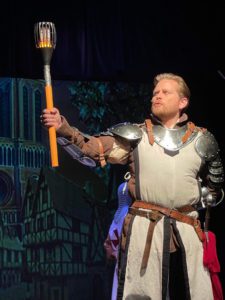 Also worth noting is the beautiful costume design by Kylee Larsen and Stacee Hunsaker. Esmeralda’s costume was multi-layered, adorned with gold embellishments, and moved beautifully when she danced. The different robes and costumes worn by Frollo were also detailed and eye-catching. It would have been nice to see a little more detail on the gargoyle costumes, which were simply gray shirts, gray leggings, and small masks worn over their eyes, but the costumes were generally impressive and added to the story.
Also worth noting is the beautiful costume design by Kylee Larsen and Stacee Hunsaker. Esmeralda’s costume was multi-layered, adorned with gold embellishments, and moved beautifully when she danced. The different robes and costumes worn by Frollo were also detailed and eye-catching. It would have been nice to see a little more detail on the gargoyle costumes, which were simply gray shirts, gray leggings, and small masks worn over their eyes, but the costumes were generally impressive and added to the story.
Jensen gives a terrifyingly powerful performance as Claude Frollo. His rendition of “Hellfire” was bone-chilling. Jensen is a strong vocalist and does well with portraying his internal struggle with his lustful feelings for Esmeralda. His assault scene with Esmeralda in Act 2 was a well crafted performance that did not cross the line into being uncomfortable and inappropriate. Frollo’s complete loss of self-control and Esmeralda’s genuine terror were vividly portrayed by both actors, and this was one of the most powerful scenes in the show.
One of the strongest performers in the cast was Eric Smith as Phoebus. Smith is clearly the most skilled vocalist in the cast. He navigates his songs with ease and agility, and his voice is extremely pleasing to listen to. He also had many powerful and moving acting moments, particularly during the song “Someday,” which he performed with West, and during Esmeralda’s death scene. His chemistry with West is excellent, and his devastation at her death was extremely moving.
Esmeralda’s death scene was less effective, as no special effects were used to create the illusion of smoke or fire. It was unclear what exactly caused her death. However, all of the actors involved in this scene did well with telling the story, despite the lack of special effects. Another effect that repeatedly failed to work was the “magic” effect used by the gypsies. Because this effect never seemed to work, it was unclear what was happening in these scenes. “Magic” and “witchcraft” were frequently referenced without there ever actually being any magic or witchcraft occurring.
There were also some minor issues with microphones, as some of the microphones worn by the leading characters caused their voices to sound muffled or tinny. The levels on the microphones were imbalanced, and some ensemble members were much louder than others. Sometimes the mic levels on certain singers would be extremely loud when they first came in, and the volume of their mic would be noticeably adjusted during the scene. Other times, the microphones for some characters did not work at all. However, due to the small space and the projection of the strong performers in this cast, not many of the spoken or singing lines were lost due to microphone issues.
This production of The Hunchback of Notre Dame is an excellent example of what a cast of strong performers and a dedicated production team can create with a small space and limited resources. This was one of the best productions I have ever seen performed at Draper Historic Theatre. Although the theatre is small, they attract great talent and create beautiful stories. This production is not recommended for younger children, as it deals with mature subject matter and may be frightening to young audience members, but for the adults, it is definitely worth seeing.
[box]The Hunchback of Notre Dame plays Mondays, Fridays, and Saturdays at 7 PM through May 21, with matinees on May 14 and May 21 at 2 PM at Draper Historic Theatre (12366 South 900 East, Draper). Tickets are $10-$15. For more information, visit drapertheatre.org.[/box]

